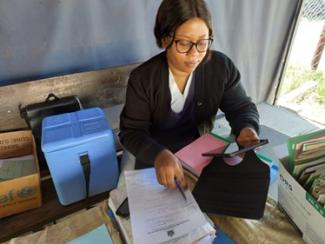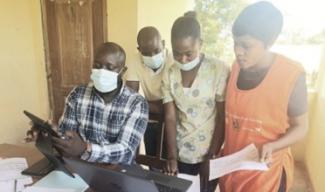USAID Collaboration Strengthens COVID-19 Surveillance and Reporting at District and National Levels in Zambia
At the close of each day, Luyando Handya, the Acting Manager of Kamitondo Clinic in Zambia's Kitwe District, holds her tablet in her hands, carefully adding data on the number of COVID-19 tests, cases, and vaccinations that were recorded that day. With support from the USAID Evidence for Health project, in collaboration with the Zambia National Public Health Institute (ZNPHI), Luyando and other health facility staff members have been equipped with electronic devices (tablets) and trained to collect key data. They are now able to ensure that COVID-19 data is captured and reported in an efficient and effective way-even from health facilities that are located in rural and remote areas.
At the beginning of the pandemic, collecting and managing data on COVID-19 in Zambia was challenging. The process was difficult because COVID-19 data was largely captured through a paper-based system and hard copies of data were sent manually via road transport, using a car, public bus, or even sometimes on bicycle or foot, to a central point at the District Health Office for entry into the reporting system. Lydia Mande, an Environmental Health Technician at a rural health center stated that, “Inadequate transport coupled with a poor road network made it impossible for the facility to share COVID-19 surveillance and vaccination data in a timely way with the District Health Office daily.”
With many challenges such as diverse terrain, roads in a state of disrepair, and long distances, the turnaround time to post COVID-19 data into the central Ministry of Health (MoH) reporting system took an average of two to three days, especially for health facilities located in rural areas. This meant that national statistics on COVID-19 were always delayed and did not reflect the day-to-day situation—a problem which was critically important in a context that was rapidly changing and for a disease that was affecting more people by the day.
“Decision making was compromised because not all numbers were posted on the central reporting system on time due to delays in data submission by the health facilities,” said Kakusa Kakusa, a Health Information Officer in Lufwanyama District. “Therefore, this affected real time decision making on appropriate interventions to employ per geographic area.”
The lack of real-time COVID-19 data revealed the importance of having up-to-date information to help inform public health policy decisions and interventions.
Using real-time COVID-19 data for routine analysis was critical to understand how the disease was burdening the country and to inform timely and targeted interventions. The head of ZNPHI commented that, “In the context of health crises, routine analysis of data is essential for making strategic decisions, with real-time data at our fingertips, so that responses to the pandemic are quick and targeted.”
To bridge the gap, a total of 900 health facilities in USAID Evidence for Health project-supported provinces (Central, Copperbelt, Luapula, and Northern) received electronic devices and health care workers were oriented on capturing data electronically. Electronic reporting of COVID-19 data has guaranteed that this information is available in real-time and has increased the accuracy and completeness of the data.
The data entry burden at the District Health Information Office (DHIO) level has also been reduced, which has freed up time for staff to focus on other monitoring and evaluation responsibilities.
Simbaya Lumbwe, Surveillance Officer from Kalulushi District Health Office emphasized, “In this COVID-19 era where travel is restricted, facilities can now submit COVID-19 data remotely. Opening direct access to health facilities to upload data into the system promotes data ownership, use, and more timely submission of data. Furthermore, it presents an opportunity for early detection of errors thereby strengthening quality assurance.”
With the addition of the electronic devices to aid with reporting, data on COVID-19 is now collected at the facility level and captured at the national level in as timely a manner as possible, with a target turnaround time of 24 hours. When there is a surge in data, such as during national COVID-19 vaccination campaigns, capturing the data takes longer; however, with support from the USAID Evidence for Health project for electronic reporting, delays are minimized and data is made available as soon as possible.
For Luyando and Lydia who work in district and rural health facilities, this support from the USAID Evidence for Health project has made a world of a difference in making their work more efficient and effective. Ultimately, the Ministry of Health and ZNPHI now consistently have data at their fingertips to quickly and appropriately respond to COVID-19.

USAID Evidence for Health

